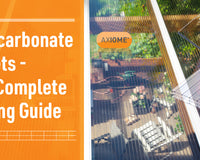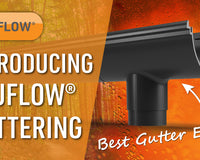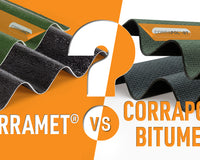You probably know that polycarbonate sheets are very strong and therefore in theory you might think you should be able to walk on them? This may be for where access is required for cleaning or maintenance, however, whatever the reason there are important factors why you should never stand or walk on polycarbonate sheets.
So, if you need to access the top of a polycarbonate roof, what should you do instead of walking on top? In this article, we discuss the dangers and the alternative options you might want to consider for accessing polycarbonate roofs. When talking about polycarbonate roofs we should probably say that the same precautions generally apply to all glazed roofs, such as glass roofs.
4 Problems with Walking on Polycarbonate Roofs?
There are many reasons why people want to access the top of their polycarbonate roofs, so it’s important to understand the problems with walking, climbing, or standing on Polycarbonate roofs. Here are 4 problems with Walking on a glazed Polycarbonate Roof:
- High Risk of Serious or Even Fatal Injury
- Damage to Glazing Bar Gaskets and Fixings Causing Leaks
- Scratches, Denting or Breakage to Polycarbonate Glazing Sheets
- Repairing Polycarbonate Roofs is Difficult & Costly Even for Experts
Let's go through each of these in detail...
- Serious Risk of Serious or Even Fatal Injury
- Damage to Glazing Bar Gaskets and Fixings Causing Leaks
- Scratches, Denting or Breakage to Polycarbonate Glazing Sheets
- Repairing Polycarbonate Roofs is Difficult & Costly Even for Experts
You would never plan to damage your Polycarbonate Roof – we get that – but should you ever have to repair your roof due to some unfortunate happening, it can be difficult to make the replacement roof parts match in and look correct against parts of the original polycarbonate roof. In addition, where some of the structure may have become slightly out of line, then trying to get the gaskets to properly seal can be a major challenge and costly. So, you want to avoid causing any damage to Polycarbonate Roofs by risking standing or walking on them, even if you feel it has been made safe to do so.
Here Are 4 Alternatives to Standing on Polycarbonate Roofs?
- Use Long Handled Tools
- Use Suitable Ladders
- Hire and Use a Scaffold Tower
- Consider if it is Safe to Use a Crawling Board (with caution)
So, let's dive deeper into each of these alternatives...
- Use Long-Handled Tools
Depending on the task you are doing, it's amazing what tools you can buy to undertake tasks from the ground with extended poles etc to reach up onto roofs. For example, cleaning your roof can be done easily with a long-pole attachment for various cleaning tools such as Hosepipes, Squeegees or Sponges. So, consider firstly, do you have to get on top of the roof, or can you find a way to avoid the risks entirely?
- Use Suitable Ladders
Depending on the size of the roof, you may be able to access much of the area above it using suitable ladders. Always take appropriate safety precautions, ensure you have the training and follow the ladder manufacturer’s safety and training advice. You may think this is as risky as climbing on the roof itself, however, bear in mind that ladders are designed to be climbed on; whereas polycarbonate roofs are generally not designed to be accessed on top.
- Hire and use Scaffold Tower
For larger projects or where roof access can’t be made in earlier suggestions above, you may want to consider hiring a scaffold tower, which is relatively inexpensive and most hire companies should help you to erect the scaffold tower safely – You should always follow their safety advice and get them to train you. Depending on your roof shape and size, you should be able to hire scaffold tower systems that will allow you to easily access your roof in a much safer way than taking the risks of climbing on the actual glass or polycarbonate roof itself.
- Consider if it is Safe to Use a Crawling Board (with caution)
Important Safety Note: The above points are only very general arm’s length advice, given in good faith, and should not be taken as a recommendation to act in any particular manner or with any particular method. Don’t take risks, and always check with a professional before accessing your roof, and if possible, avoid any work at heights, so you stay safe.
Below is some Additional Related Roof Information that we thought you might also find helpful:
What Types of Roofs are There?
- Sloped Tiled Roofs: These roofs are usually pitched or sloped roofs, created with a layer of felt on top of the roofing timbers, and then clay or concrete tiles are nailed on top. Many concrete tile manufacturers create different styles and shapes of tile to suit different housing or building schemes.
- Flat Felt Roofs: Traditionally, flat roofs were often covered with bituminous felt, however, PVC or Rubber flat roofing membranes have become more popular recently, as they last far longer than bituminous felt, and help reduce the possibility of roofs leaking.
- Glazed Roofs: Where daylight is required in a roof, you can create a Glazed Roof or combine a flat or sloped roof with a Roof Lantern. You can glaze these rooflights with more expensive glass options from glass unit manufacturers or use Polycarbonate Roofing Sheet options which are much lower cost and easier to handle.
- Polycarbonate Roofs: These are where a Glazed roof is made using Polycarbonate roofing sheets. Polycarbonate roofs are around 50% lower cost than glazed roofs made with glass units and are as much as 75% lighter weight than glass roofs.
What are the 3 Types of Polycarbonate Sheets?
Polycarbonate Sheets are plastic sheets that are made from a very strong resin which means they are perfect for roofing and glazing. Polycarbonate sheets are mostly clear, or tinted sheets and are manufactured in three main types of sheets as follows:
- Twinwall Polycarbonate Sheets are made with two or more layers so they have a box section structure, which is great for rigidity and insulation properties. Twinwall Polycarbonate Sheets are sometimes called ‘Multiwall Polycarbonate’ because there are sometimes 3 or 4 layers, especially on the thicker sheet Gauges. Multiwall Polycarbonate sheets are manufactured in 4mm, 6mm, 10mm, 16mm, 25mm and 35mm thicknesses.
- Solid Polycarbonate Sheets are made from one solid layer of polycarbonate resin and look very similar to glass. Solid polycarbonate sheets are slightly more flexible than glass, but are approximately 200 times the strength of glass and therefore reckoned to be virtually unbreakable. Normally, Solid Polycarbonate sheets are manufactured in 2mm, 3mm, 4mm, 5mm, 6mm, 8mm, 10mm or 12mm thickness.
- Corrugated Polycarbonate Sheets are sheets that are made with a curved wave pattern, which creates relatively rigid sheet. This means that Corrugated Polycarbonate Sheets can be manufactured using only a 1mm thickness, but with the corrugations, the overall thickness is normally over 30mm, which provides the needed strength and rigidity. This in turn keeps the costs as low as possible, whilst providing great strength and longevity.
Are Polycarbonate Sheets Stronger than PVC Sheets?
Yes, Polycarbonate Sheets are much stronger than PVC Sheets and are reckoned to last 4 times as long. Polycarbonate Roofing Sheets are estimated to be over 20 times stronger than PVC Roofing Sheets. PVC Roofing sheets tend to discolour relatively quickly and go brittle after as little as 2 - 3 years, whereas Polycarbonate Sheets should normally stay relatively clear and strong for 20 years and beyond.
When you consider that your rafters, posts, frames etc should most likely last well over 20 years, then it makes very good sense to choose polycarbonate roof sheets so they last a similar length of time, rather than PVC Sheets which make need to be replaced in 4 to 5 years. PVC Roofing sheets, however, are more suited to a shorter-term or temporary project.
Need further Advice on Your Project?
Our Teams are very happy to assist on our Live Chat or, you can email shop@clearamber.com where our super friendly Teams will provide you with all the advice and support you require for your projects.
Place Your Order Today – Get Same Day Despatch, Free Returns & Flexible Payment!
At Clear Amber Shop you can have total peace of mind with:
- Get SWIFT Guaranteed Same Day Despatch for rapid delivery
- Return items within the scope of our NQS Returns Policy
- Spread or delay the payment by choosing our Flexible Payment Options
- Register your products for Total Lifespan® Warranty
Our Teams are here to support you every step of the way - Talk Soon...















2 comments
Anonymous
Thanks Richard. You are best to start one side and work across sheet by sheet, fixing down the glazing bars as you go. If you keep the sheets a sensible width (e.g. 4 × 750mm wide Axiome 16mm Polycarbonate) then not only is it better for spanning but you can reach over to fix the sheets down.
Once you have a couple sheets in place it is possible to use a crawling board resting on the installed glazing bars. However, it is possible to do a whole roof without.
Richard Maçnell
How can you fix bars on roof without standing on sheets? I’m covering a 3m square pergola.